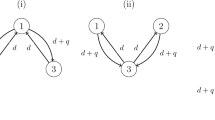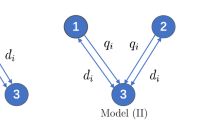Abstract
In this paper, we study a three-patch two-species Lotka–Volterra competition patch model over a stream network. The individuals are subject to both random and directed movements, and the two species are assumed to be identical except for the movement rates. The environment is heterogeneous, and the carrying capacity is lager in upstream locations. We treat one species as a resident species and investigate whether the other species can invade or not. Our results show that the spatial heterogeneity of environment and the magnitude of the drift rates have a large impact on the competition outcomes of the stream species.











Similar content being viewed by others
References
Altenberg, L.: Resolvent positive linear operators exhibit the reduction phenomenon. Proc. Natl. Acad. Sci. USA 109(10), 3705–3710 (2012)
Cantrell, R.S., Cosner, C., Deangelis, D.L., Padron, V.: The ideal free distribution as an evolutionarily stable strategy. J. Biol. Dyn. 1(3), 249–271 (2007)
Cantrell, R.S., Cosner, C., Lou, Y.: Movement toward better environments and the evolution of rapid diffusion. Math. Biosci. 204(2), 199–214 (2006)
Cantrell, R.S., Cosner, C., Lou, Y.: Evolution of dispersal in heterogeneous landscapes. In: Cantrell, S., Cosner, C., Ruan, S. (eds.) Spatial Ecology, pp. 213–229. CRC Press, Boca Raton (2010)
Cantrell, R.S., Cosner, C., Lou, Y.: Evolutionary stability of ideal free dispersal strategies in patchy environments. J. Math. Biol. 65(5), 943–965 (2012)
Cantrell, R.S., Cosner, C., Lou, Y., Schreiber, S.J.: Evolution of natal dispersal in spatially heterogeneous environments. Math. Biosci. 283, 136–144 (2017)
Chen, S., Liu, J., Wu, Y.: Invasion analysis of a two-species Lotka–Volterra competition model in an advective patchy environment. Stud. Appl. Math. 149, 762–797 (2022)
Chen, S., Shi, J., Shuai, Z., Wu, Y.: Global dynamics of a Lotka–Volterra competition patch model. Nonlinearity 35(2), 817 (2022)
Chen, S., Shi, J., Shuai, Z., Wu, Y.: Two novel proofs of spectral monotonicity of perturbed essentially nonnegative matrices with applications in population dynamics. SIAM J. Appl. Math. 82(2), 654–676 (2022)
Chen, S., Shi, J., Shuai, Z., Wu, Y.: Evolution of dispersal in advective patchy environments. J. Nonlinear Sci. 33, 40 (2023)
Chen, X., Lam, K.-Y., Lou, Y.: Dynamics of a reaction–diffusion–advection model for two competing species. Discrete Contin. Dyn. Syst. 32(11), 3841 (2012)
Cheng, C.-Y., Lin, K.-H., Shih, C.-W.: Coexistence and extinction for two competing species in patchy environments. Math. Biosci. Eng. 16(2), 909–946 (2019)
Cosner, C.: Variability, vagueness and comparison methods for ecological models. Bull. Math. Biol. 58(2), 207–246 (1996)
Dieckmann, U., Law, R.: The dynamical theory of coevolution: a derivation from stochastic ecological processes. J. Math. Biol. 34(5), 579–612 (1996)
Dockery, J., Hutson, V., Mischaikow, K., Pernarowski, M.: The evolution of slow dispersal rates: a reaction diffusion model. J. Math. Biol. 37(1), 61–83 (1998)
Geritz, S., Kisdi, E., Mesze, G., Metz, J.A.J.: Evolutionarily singular strategies and the adaptive growth and branching of the evolutionary tree. Evol. Biol. 12(1), 35–57 (1998)
Gourley, S.A., Kuang, Y.: Two-species competition with high dispersal: the winning strategy. Math. Biosci. Eng. 2(2), 345–362 (2005)
Hamida, Y.: The Evolution of Dispersal for the Case of Two-Patches and Two-Species with Travel Loss. PhD thesis, The Ohio State University (2017)
Hastings, A.: Can spatial variation alone lead to selection for dispersal? Theor. Popul. Biol. 24(3), 244–251 (1983)
Hess, P.: Periodic–Parabolic Boundary Value Problems and Positivity, volume 247 of Pitman Research Notes in Mathematics Series. Longman Scientific & Technical, Harlow (1991)
Hsu, S.B., Smith, H.L., Waltman, P.: Competitive exclusion and coexistence for competitive systems on ordered Banach spaces. Trans. Am. Math. Soc. 348(10), 4083–4094 (1996)
Huang, Q.-H., Jin, Y., Lewis, M.A.: \(R_0\) analysis of a Benthic-drift model for a stream population. SIAM J. Appl. Dyn. Syst. 15(1), 287–321 (2016)
Jiang, H., Lam, K.-Y., Lou, Y.: Are two-patch models sufficient? The evolution of dispersal and topology of river network modules. Bull. Math. Biol. 82(10), 131, 42 (2020)
Jiang, H., Lam, K.-Y., Lou, Y.: Three-patch models for the evolution of dispersal in advective environments: varying drift and network topology. Bull. Math. Biol. 83(10), 109, 46 (2021)
Jin, Y., Lewis, M.A.: Seasonal influences on population spread and persistence in streams: critical domain size. SIAM J. Appl. Math. 71(4), 1241–1262 (2011)
Johnson, M.L., Gaines, M.S.: Evolution of dispersal: theoretical models and empirical tests using birds and mammals. Ann. Rev. Ecol. Syst. 21, 449–480 (1990)
Kirkland, S., Li, C.-K., Schreiber, S.J.: On the evolution of dispersal in patchy landscapes. SIAM J. Appl. Math. 66(4), 1366–1382 (2006)
Lam, K.Y., Lou, Y., Lutscher, F.: Evolution of dispersal in closed advective environments. J. Biol. Dyn. 9(suppl. 1), 188–212 (2015)
Lam, K.-Y., Munther, D.: A remark on the global dynamics of competitive systems on ordered Banach spaces. Proc. Am. Math. Soc. 144(3), 1153–1159 (2016)
Levin, S.A., Cohen, D., Hastings, A.: Dispersal strategies in patchy environments. Theor. Popul. Biol. 26(2), 165–191 (1984)
Li, M.Y., Shuai, Z.: Global-stability problem for coupled systems of differential equations on networks. J. Differ. Equ. 248(1), 1–20 (2010)
Lin, K.-H., Lou, Y., Shih, C.-W., Tsai, T.-H.: Global dynamics for two-species competition in patchy environment. Math. Biosci. Eng. 11(4), 947–970 (2014)
Lou, Y.: Ideal free distribution in two patches. J. Nonlinear Model Anal. 2, 151–167 (2019)
Lou, Y., Lutscher, F.: Evolution of dispersal in open advective environments. J. Math. Biol. 69(6–7), 1319–1342 (2014)
Lou, Y., Nie, H., Wang, Y.: Coexistence and bistability of a competition model in open advective environments. Math. Biosci. 306, 10–19 (2018)
Lou, Y., Xiao, D.-M., Zhou, P.: Qualitative analysis for a Lotka–Volterra competition system in advective homogeneous environment. Discrete Contin. Dyn. Syst. 36(2), 953–969 (2016)
Lou, Y., Zhao, X.-Q., Zhou, P.: Global dynamics of a Lotka–Volterra competition–diffusion–advection system in heterogeneous environments. J. Math. Pures Appl. 9(121), 47–82 (2019)
Lou, Y., Zhou, P.: Evolution of dispersal in advective homogeneous environment: the effect of boundary conditions. J. Differ. Equ. 259(1), 141–171 (2015)
Lu, Z.Y., Takeuchi, Y.: Global asymptotic behavior in single-species discrete diffusion systems. J. Math. Biol. 32(1), 67–77 (1993)
Lutscher, F., Lewis, M.A., McCauley, E.: Effects of heterogeneity on spread and persistence in rivers. Bull. Math. Biol. 68(8), 2129–2160 (2006)
Lutscher, F., McCauley, E., Lewis, M.A.: Spatial patterns and coexistence mechanisms in systems with unidirectional flow. Theor. Popul. Biol. 71(3), 267–277 (2007)
Lutscher, F., Pachepsky, E., Lewis, M.A.: The effect of dispersal patterns on stream populations. SIAM Rev. 47(4), 749–772 (2005)
Ma, L., Tang, D.: Evolution of dispersal in advective homogeneous environments. Discrete Contin. Dyn. Syst. 40(10), 5815–5830 (2020)
McPeek, M.A., Holt, R.D.: The evolution of dispersal in spatially and temporally varying environments. Am. Nat. 140(6), 1010–1027 (1992)
Noble, L.: Evolution of Dispersal in Patchy Habitats. PhD thesis, The Ohio State University (2015)
Smith, H.L.: Monotone Dynamical Systems: An Introduction to the Theory of Competitive and Cooperative Systems. American Mathematical Society, Providence (1995)
Speirs, D.C., Gurney, W.S.C.: Population persistence in rivers and estuaries. Ecology 82(5), 1219–1237 (2001)
Vasilyeva, O., Lutscher, F.: Population dynamics in rivers: analysis of steady states. Can. Appl. Math. Q. 18(4), 439–469 (2010)
Vasilyeva, O., Lutscher, F.: How flow speed alters competitive outcome in advective environments. Bull. Math. Biol. 74(12), 2935–2958 (2012)
Xiang, J.-J., Fang, Y.: Evolutionarily stable dispersal strategies in a two-patch advective environment. Discrete Contin. Dyn. Syst. B 24(4), 1875 (2019)
Yan, X., Nie, H., Zhou, P.: On a competition–diffusion–advection system from river ecology: mathematical analysis and numerical study. SIAM J. Appl. Dyn. Syst. 21(1), 438–469 (2022)
Zhao, X.-Q., Zhou, P.: On a Lotka–Volterra competition model: the effects of advection and spatial variation. Calc. Var. Partial Differ. Equ. 55(4), 73 (2016)
Zhou, P.: On a Lotka–Volterra competition system: diffusion vs advection. Calc. Var. Partial Differ. Equ. 55(6), 137 (2016)
Author information
Authors and Affiliations
Corresponding author
Additional information
Publisher's Note
Springer Nature remains neutral with regard to jurisdictional claims in published maps and institutional affiliations.
Shanshan Chen is supported by National Natural Science Foundation of China (Nos. 12171117, 11771109) and Shandong Provincial Natural Science Foundation of China (No. ZR2020YQ01).
Appendix
Appendix
In the Appendix, we study the relations of \({{\overline{q}}}\), \({\underline{q}}\) and \(q_0\). For convenience, we recall the definition of \({{\overline{q}}}\), \({\underline{q}}\) and \(q_0\):
Lemma 6.4
Suppose that \((\textbf{H})\) holds, \(\varvec{r}\gg \varvec{0}\), and \(d_1,q_1>0\). Then, the following statements hold:
-
(i)
If \(q_1<{\underline{q}}\), then \(q_0>q_1\);
-
(ii)
If \(q_1>{{\overline{q}}}\), then \(q_0<q_1\);
-
(iii)
If \(q_1>{\underline{q}}\), then \(q_0>{\underline{q}}\);
-
(iv)
If \(q_1<{{\overline{q}}}\), then \(q_0<{{\overline{q}}}\).
Proof
By (5.10) and (5.11) and Lemma 5.1 (i), we have
which will be used in the proof below.
(i) By Lemma 5.1 (iv), we have \(u^*_1>u^*_2>u^*_3\). This, together with (6.9c) and (6.10a), implies that
(ii) By Lemma 5.1 (iii), we have \(u^*_1<u^*_2<u^*_3\). Then, by (6.10a) again, we obtain
By (6.10c), we obtain that
where we have used (6.10c) and \(u_2^*<u_3^*\) in the last step. It follows from (6.9c), (6.12) and (6.13) that \(q_0<q_1\).
(iii) We divide the proof into three cases:
For case (A1), we see from (6.9b) and (6.9c) that
For case (A2), we see from (6.9c) and (6.10a) that
Now we consider (A3). Suppose to the contrary that \(q_0\le {\underline{q}}\). This, combined with (6.9b) and (6.9c), yields
Noticing that \(u_2^*>k_2\), we see from (6.10c) that
Since \(u^*_1< u^*_2\), we see from (6.15) that \(u^*_2< u^*_3\). Then, we have
which yields
This, together with (6.16), (6.10a) and (6.10b), implies that
which contradicts (6.14). Therefore, \(q_0>{\underline{q}}\) for case (A3).
(iv) We first show that
and the proof is divided into three cases:
For case (B1), we have
For case (B2), we see from (6.10a) that
For case (B3), using similar arguments as the above case (A3), we have
This, combined with (6.10a) and (6.10b), implies that
Then, we show that
and the proof is also divided into three cases:
For case (C1), we see from (6.13) that
For case (C2), we have
For case (C3), we see from (6.10) that
By (6.18) and (6.20), we see that (iv) holds. \(\square \)
Remark 6.5
By \({\underline{q}}\le {{\overline{q}}}\) and Lemma 6.4, we see that if \(q_1< {\underline{q}}\), then \(q_1<q_0<{{\overline{q}}}\); if \(q_1> {{\overline{q}}}\), then \({\underline{q}}<q_0<q_1\); and if \({\underline{q}}<q_1<{{\overline{q}}}\), then \({\underline{q}}<q_0<{{\overline{q}}}\).
Rights and permissions
Springer Nature or its licensor (e.g. a society or other partner) holds exclusive rights to this article under a publishing agreement with the author(s) or other rightsholder(s); author self-archiving of the accepted manuscript version of this article is solely governed by the terms of such publishing agreement and applicable law.
About this article
Cite this article
Chen, S., Liu, J. & Wu, Y. On the impact of spatial heterogeneity and drift rate in a three-patch two-species Lotka–Volterra competition model over a stream. Z. Angew. Math. Phys. 74, 117 (2023). https://doi.org/10.1007/s00033-023-02009-6
Received:
Revised:
Accepted:
Published:
DOI: https://doi.org/10.1007/s00033-023-02009-6
Keywords
- Lotka–Volterra competition model
- Patch environment
- Evolution of dispersal
- Directed drift
- Random movement




